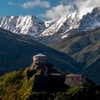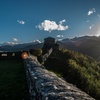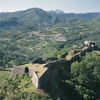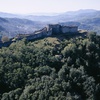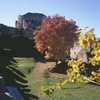Fort of Verrucole
Fort Verrucole stands majestically on a spur of rock just outside the town of San Romano in Garfagnana.
The first detailed description of this military structure dates from the 15th century. On the Verrucole hill were two separate and distinct fortified housing clusters: the “Square Fort” was located to the north and has now almost completely disappeared, while the “Round Fort” is located to the south and still preserves its main structures.
The “Round Fort” is actually a polygonal structure of fifteen sides, with a curved reinforcement. The fort was originally rather low and only later, probably during the reign of the House of Este, was it decided to add a new floor, as evidenced by the battlements in the Guelph style that are still clearly identifiable.
The other defensive structure, perhaps the oldest of the site, the Rocha Quadra, was likely originally an isolated tower that only later was equipped with a defensive surrounding wall. This structure, replaced by will of the House of Este with two large bastions, remains visible only in a short stretch of wall.
Historical notes
The site, which had been populated since prehistoric times, was occupied during the Middle Ages by a small village under the jurisdiction of the Gherardinghi, one of the major factions of the Garfagnana area. We do not know in which year construction of the fortifications began, but the first written record dates from 1027.
The fort remained in the hands of the Gherardinghi until 1170 when, following the repression of the rebellion of the nobles of Garfagnana, the castle was attractive to the Commune of Lucca who assumed full authority for it in 1292.
In the early 14th century, there emerged a new Lunigianese ruling lineage, Spinetta Malaspina, who was awarded the Imperial Vicariate by Arrigo VII. Fort Verrucole subsequently became part of the system of fortifications of Ghibellino Spinetta, who commissioned several renovations, including the demolition of the housing of the “Round Fort”, which had been built during the Castrucciana period.
Even in the era of the House of Este the two fortified units were distinct and with different captains and equipment. Fort Verrucole, however, certainly lost its importance over time. In 1530, the fortress was turned into a prison for brigands, who had infested the region. In 1565, both the fortifications on the site were placed under the authority of a single warden.
In 1579, a major renovation took place conducted by the engineer Marco Antonio Pasi. The architect from Carpi developed a fort of great proportions using what remained of the two older forts in order to make the most of the space available for muskets, culverins and mortars. The plans of Pasi were almost entirely realised and the fortress continued to be up-kept through the vicissitudes of the 17th and 18th centuries.
Towards the end of the 18th century, though, the fort fell into disuse and the area inside the walls were gradually occupied by meadow, field and vineyard.



